The Epoch Cassette Vision: Has Games
Oops, that last Cassette Vision post was supposed to be a review of some games for it. This is a fairly historically important console, but not a huge seller; video games didn’t really boom in Japan until the Famicom. Not a flop by any means, but maybe keep that in mind. What’s the difference between the titles on the Famicom and the titles here? Not just the giant pixels. Enjoy a whirlwind tour of randomly selected games!
Kikori no Yosaku
Since I did bring up the Neo Geo, we might as well talk SNK. Did you know that one of SNK’s earliest original games is seemingly lost media? 1979’s Yosaku, inspired by an enka song of the same name from 1978. While PCBs apparently exist in the deep depths of Japan’s arcade collector scene, all the rest of us have of it are a few videos. It seems very interesting, with some cool samples of traditional Japanese instruments (starts at 1m13s in the video, through the static); it actually got a JASRAC license.
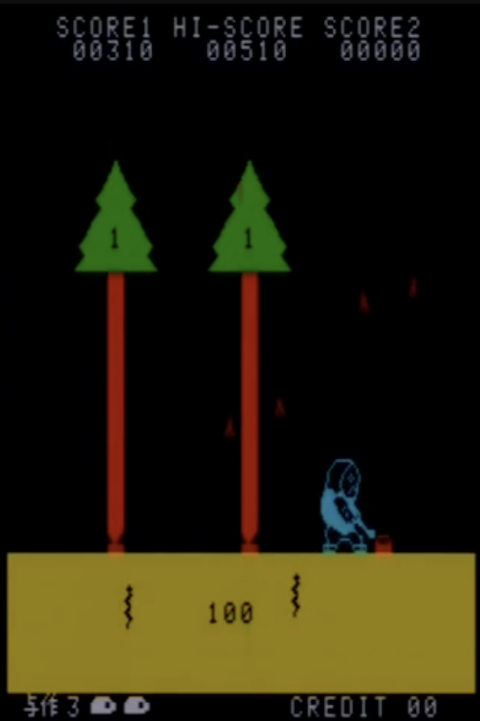
With its traditional Japanese theme, Yosaku did not see any release outside of Japan, and at the time SNK was an exceedingly small Osaka firm, so something that wasn’t a mega hit was easily possible to get lost under the rug. Still, I hope that one day I can try this game for myself. For the rest of us, there’s the Cassette Vision’s launch title: Yosaku. (Or Kikori no Yosaku, which means “The Woodcutter Yosaku”, though the front cover just says “YOSAKU” in romaji text)

Why did Epoch decide to clone Yosaku? Masayuki Horie explains:
Horie: […] We would decide on what the next game would be by watching how young people play, but we ourselves were not players. So going to the expos, we’d just have conversations with each other, like “what do you think will be popular this year? Crazy Climber, maybe?”
Something like this would’ve been in development for some time before the Cassette Vision’s 1981 launch (especially since Epoch had multiple games at launch, and only one development machine, as mentioned in the last post), so they were stuck trying to guess what the hits would be. And now this (and a Neo Geo Pocket Color easter egg, which as an official SNK product is probably closer to the real thing) are the only ways that the average person can play Yosaku.
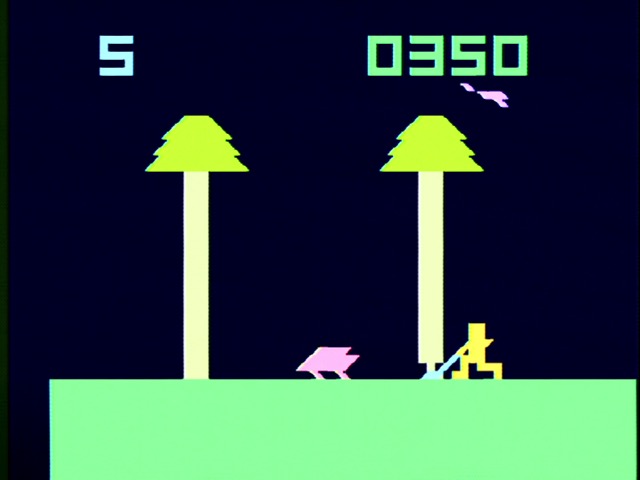
Yosaku is a fun little game; you have to constantly move around the screen, and it kind of reminds me of games like Nintendo’s 1982 Game & Watch Greenhouse, with the added complexity of needing to take action to chop down the trees, not only defend yourself. One thing that doesn’t work quite as well, however, is the jumping mechanic. I found it very hard to defend myself from the charging animals.

That’s a shame, because the jumping mechanic seems to be Epoch’s big change to Yosaku. In SNK’s version, you hide behind the trees you haven’t chopped down yet, or can use your axe. Maybe you can use your axe to attack here too, but if so the timing is even worse than the jumping. Best just to turn into a levitating cactus to escape. (The death animation)
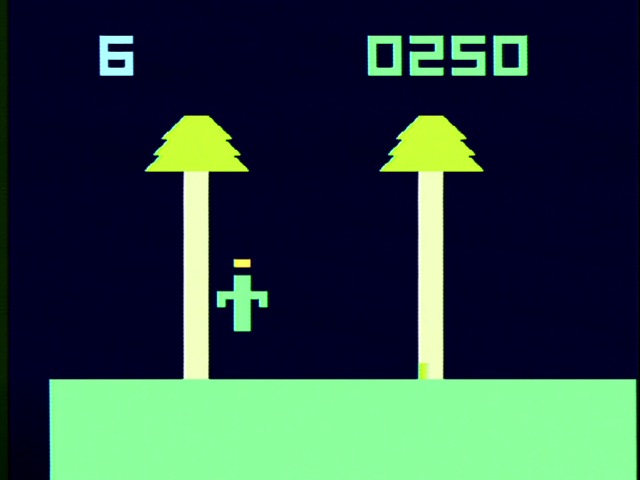
Big Sports 12
Big Sports 12 is the game the µPD777-series was designed to play. And honestly, I was pretty skeptical. See, the µPD777 series shares a characteristic with the RCA Studio II: it has fairly large blocky pixels on a fixed grid. On the Studio II’s Pong clone, this meant that movement of the ball was a bit jumpy, since it could never go to the spaces “in between” the grid. But honestly?
Big Sports 12 is fine. I suspect this is because µPD777 code, like the Atari 2600 and unlike the RCA Studio II, is fixed to run in time with the video display, and the ball therefore moves smoothly. Also, the Cassette Vision pixels are still chunky, but it has nearly twice the vertical resolution of its RCA counterpart.
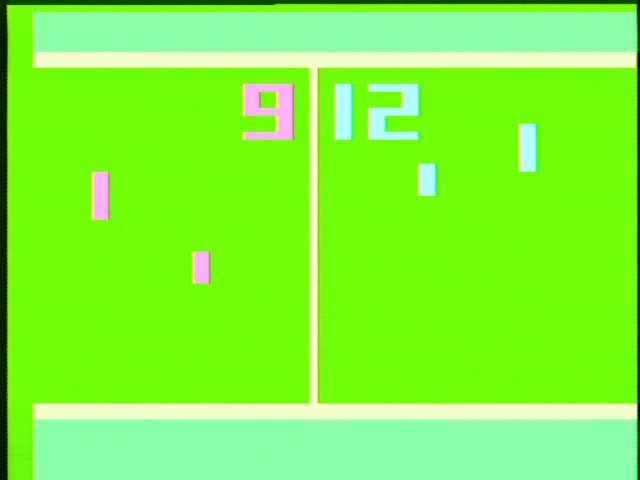
Other than that, Big Sports 12 is pretty much what you’d expect if you’ve been following all the Pong-consoles. It’s a colorful take on the game, using the dual potentiometers for each character to allow moving two paddles simultaneously, which is nice. It also is used to move in two directions, which is less nice, but hey, it worked for the Magnavox Odyssey.
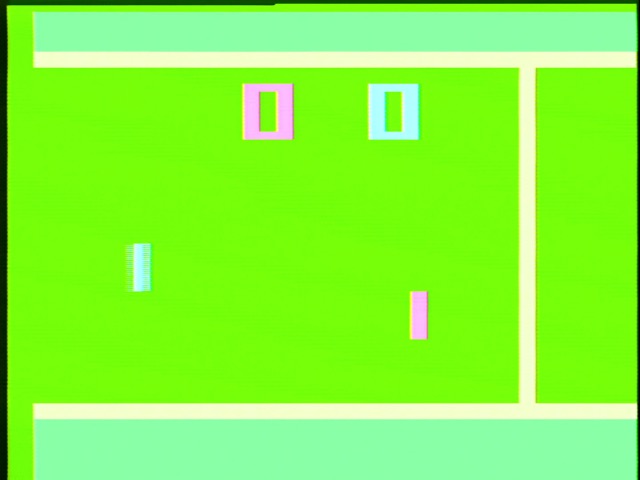
Another fun feature of Big Sports 12 is its shooting gallery. First off it has a game similar to Color TV Game 15’s shooting game. Honestly I don’t fully understand how this game works, but I did manage to shoot the moving target, so I feel pretty good about myself.
But much like the AY-3-8500, which I have narrowly dodged having to cover on this blog, it also features actual lightgun games in addition to Pong clones. Now, I don’t have the Big Sports 12 lightgun, but I do have the lightgun for Epoch’s earlier System 10 console. I’ll leave it to you to figure out why that might be. Also, this gun really wants you to know it’s a Mauser.
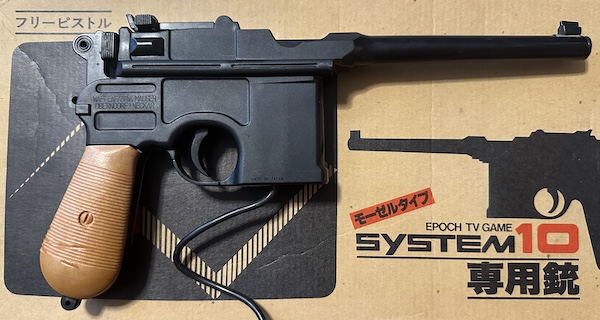
Big Sports 12 lightgun gaming is as simple as can be. There’s a target. Shoot it. This was the only game to support the Cassette Vision’s auxiliary input, which was dropped (alongside the potentiometers) on the Cassette Vision Jr. hardware.
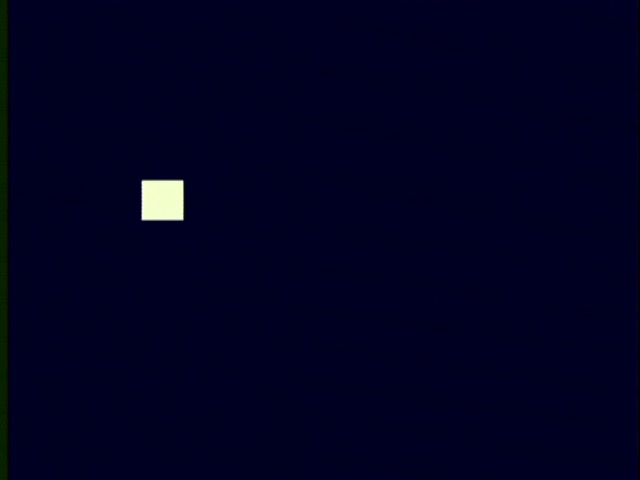
It’s not hard to see why, either. Big Sports 12 was released in 1981. By then, the market for Pong-consoles was more or less dead, even in Japan. Tetsuji Oguchi’s site claims the firmware for Big Sports 12 is the same as for the unreleased Super 10 console that was supposed to start the µPD777 line, in which case, Epoch probably just released it because it was already done, and their slow development process meant they needed all the titles they could get.
Battle Vader
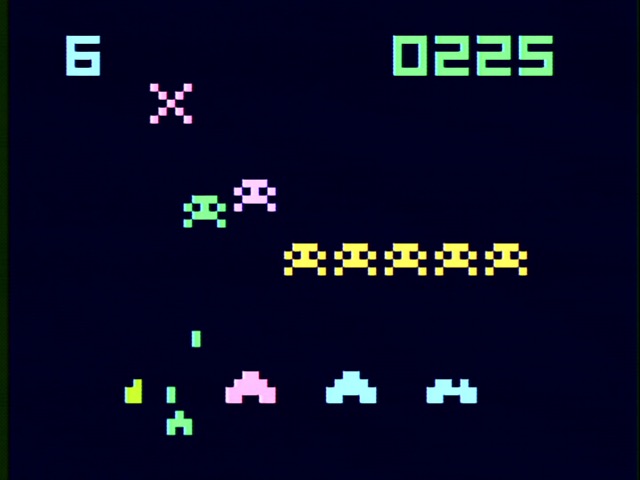
It’s literally the same thing as TV Vader, a few years later. To refresh your memory, it’s 1982 and the Cassette Vision hardware is showing its age; Battle Vader is a clone of Space Invaders that can’t display a full screen of space invaders. Just a single line, with the next becoming visible after you shoot them.
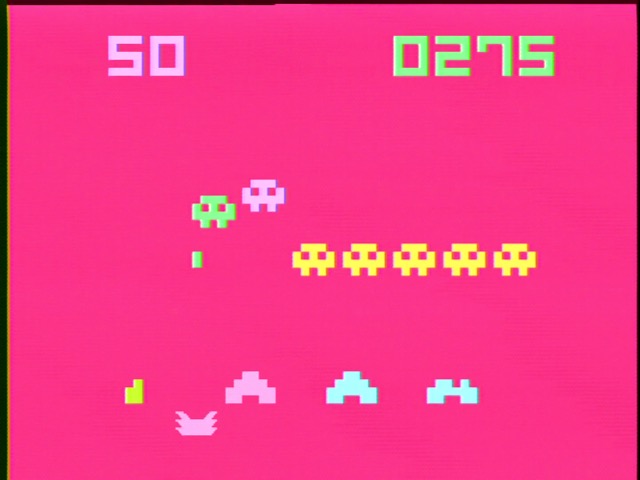
Pak-pak Monster

The Cassette Vision shows its age again. This is a clone of Pac-Man, but the low resolution of the screen and limited number of pattern elements means that there’s no way to reproduce the game’s full maze. What we get is even more limited than the Atari 2600 port.
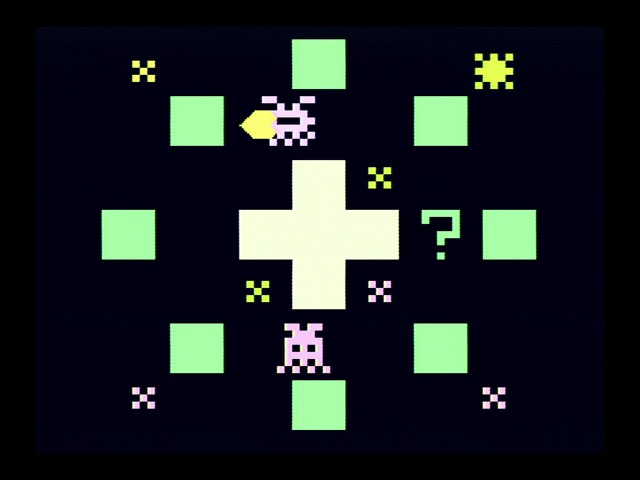
The maze is smaller, and the number of dots much fewer. To make up for this, you have to collect each dot multiple times, and can’t just collect each dot over and over; you have to collect a new one in between. Thus creating a Pac-Man clone with a possibly smaller map than even Epoch’s LCD games.
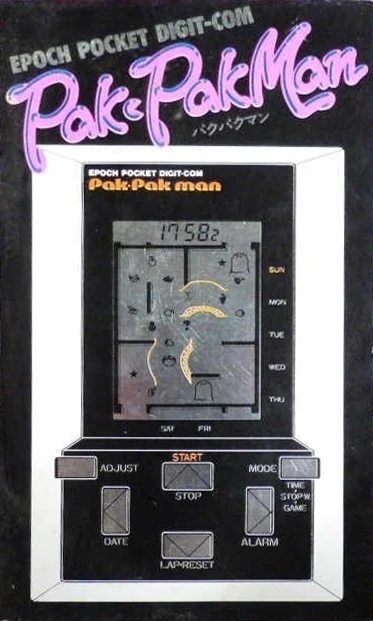
I also don’t think the enemy behavior is nearly as sophisticated. Of course, it’s harder to recreate enemy behaviors in Pac-Man when the maze is so small; Pac-Man’s ghosts will try to set up ambushes and other complex behaviors that simply can’t be done here.

To make matters worse, this game requires four-directional movement, which the Cassette Vision just doesn’t have. So instead, you have to move four ways with the four buttons in a row, as if you’re playing Pac-Man inside the vim text editor. At least the Cassette Vision Jr. fixed that problem.
Monster Mansion
Monster Mansion is a lot like Donkey Kong, but less interesting. The Famicom launched with a pretty decent Donkey Kong port, so this is one game Epoch really needed to get right to stay competitive.
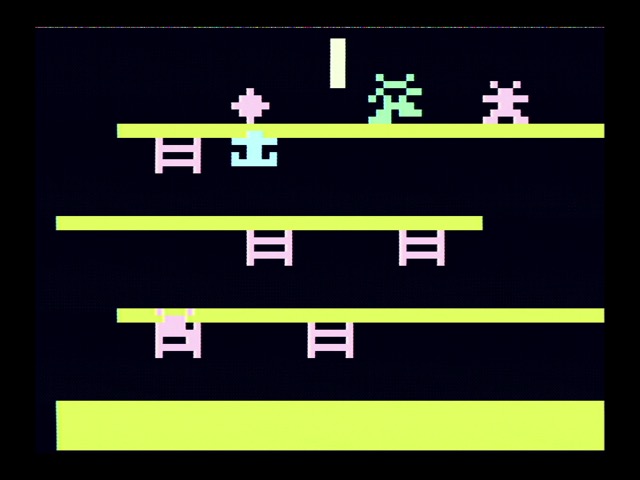
Unlike Famicom Donkey Kong, Monster Mansion does have interstitials where you progress through the building. They’re less interesting than the arcade version of Donkey Kong, with no equivalent to the charismatic ape, but at least they’re here. This is probably also a good time to note that in Japanese, a “mansion” refers to an apartment building.
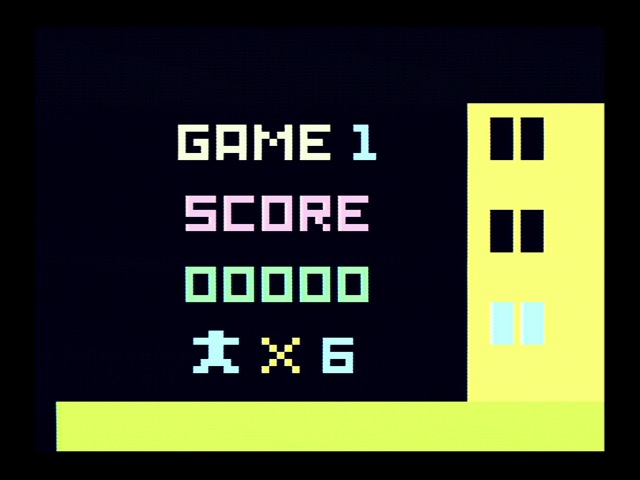
The low resolution makes it difficult to have the slanted girders, so Epoch forewent them. On this first stage, you have to climb all the ladders. Later stages use the same basic map, but with different requirements to complete the stages.
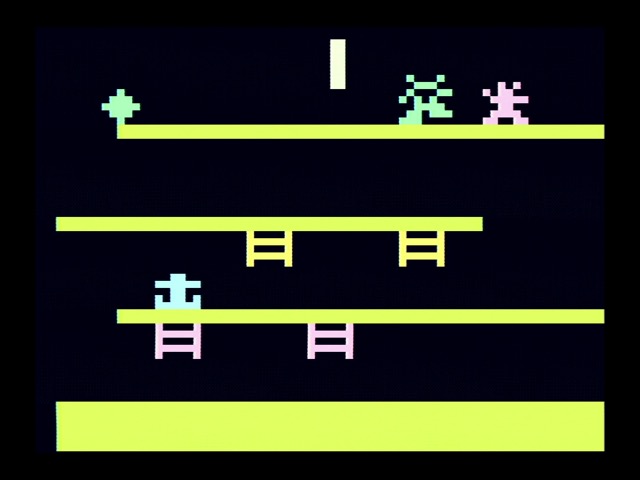
Monster Mansion isn’t bad. But it really does remind me of LCD game design, where it just has to be good enough to pass the time in a car, and it’s not expected to match the real thing. This won’t cut it in the Japanese video game market for long.
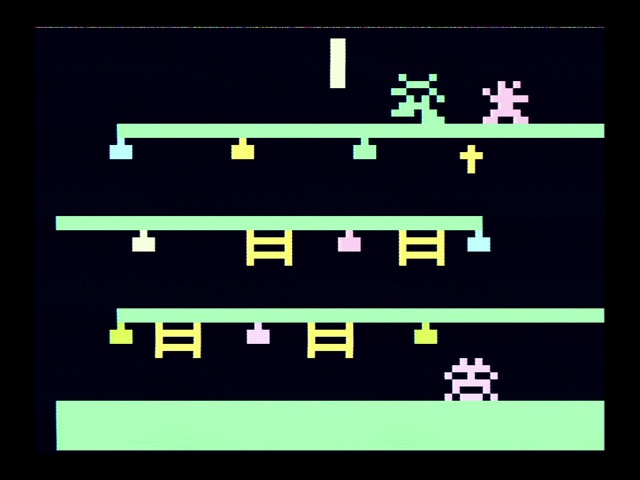
How basic is this? Perhaps it’s… Family BASIC. On YouTube, user MASANDO VISION has re-implemented Monster Mansion on the Famicom using Family BASIC V3, even with its sound effects.
Astro Command
So at this point I think the failures of the Cassette Vision are pretty clear: this system was pretty good for 1978 but was just completely outclassed by the needs of gaming in 1982. (Technology moved fast then) Arguably this is pretty similar to the situation the Atari 2600 was facing in America at the same time, but the Cassette Vision’s µPD777 architecture was less flexible and Epoch’s game development process too constrained. (Plus, no four-way digital controls) It’s not at all surprising the Famicom and SG-1000 demolished this thing.
But I don’t really want to end on such a negative note for the Cassette Vision. This console was a pioneer. And so I’ll look at my favorite game in my pitiful collection: Astro Command. This was released in August 1983, about a month after the Famicom and SG-1000 had launched.
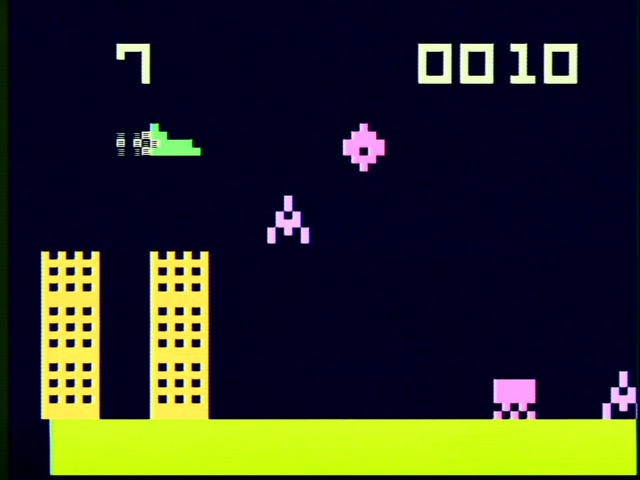
Astro Command is a horizontal scrolling shooter, and its inspiration is pretty obvious: Konami’s 1981 Scramble. You fly from left to right, and have to keep your ship fueled. Astro Command eliminates the air to ground bomb, so this is a little more challenging to get fuel when you have to be in-line with it.
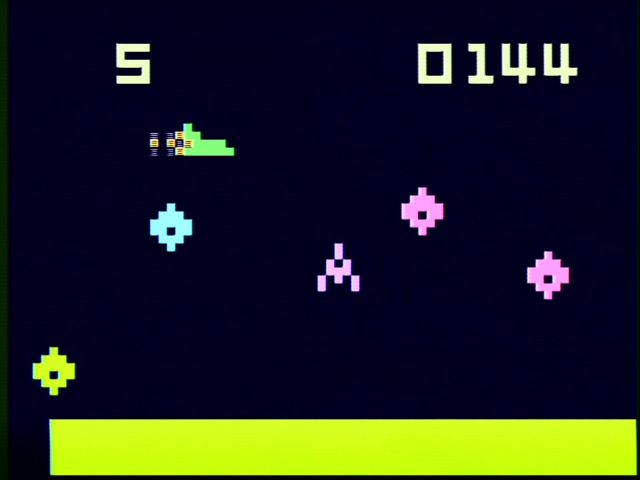
Sure, the scrolling in Astro Command is a bit chunky due to the large pixels, but arguably any form of per-pixel scrolling is still pretty good at this point. Certainly better than the SG-1000 could do. And none of the Famicom’s arcade-port launch titles made any significant use of its scrolling capabilities.
The control scheme in Astro Command is a little strange; the lever moves you up and down, button 1 fires, and button 2 gives a speed boost. It’s a little odd and unintuitive, but I got the hang of it very quickly. Honestly it kind of feels like you’re actually controlling a vehicle; the original Cassette Vision’s large array of controls helps that feel, even if many of them aren’t used– this was actually the first game to come out after the launch of the Cassette Vision Jr.
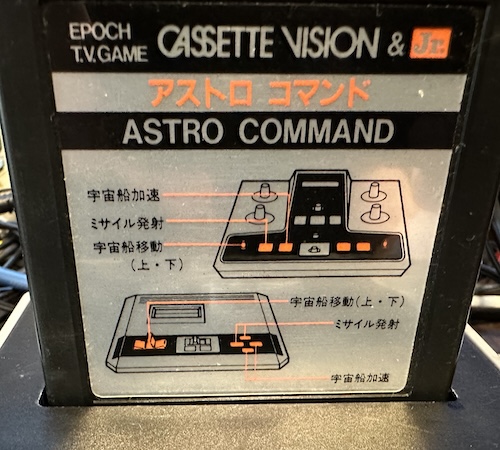
Astro Command has multiple distinct scrolling levels and a final boss. Nothing on the launch-era Famicom or SG-1000 compared to this in complexity. As I noted in my technical post when I discussed Galaxian, the sprite-based Cassette Vision was pretty good at handling moving objects. (Just not, you know, too many of them)
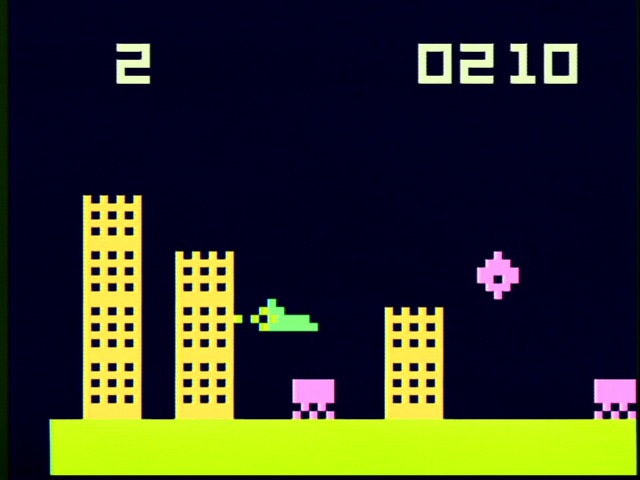
There were a few more Cassette Vision games after this, but I don’t have any of them. Epoch by this point had realized their hardware needed a refresh, and the system-on-chip approach just wasn’t economical. So a new console it was. Look forward to it!
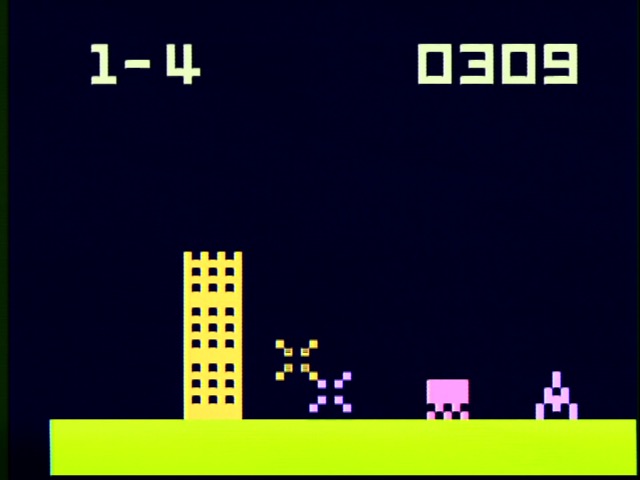
A series on: NEC and Epoch's µPD777 🎰
Digging into the Epoch and NEC collaboration that would bring us Japan's first domestically-developed game console. It's surprisingly well documented!
- How can Space Invaders Invade Your Space? The Epoch TV Vader! — Wherein the TV Vader is discussed-- a standalone µPD777-based console that plays a game similar to but legally distinct from Space Invaders.
- The Epoch Cassette Vision: Definitely Not a Pong Console in a Trenchcoat — Taking a look at the interchangeable cartridge console based around the Epoch/NEC 777-series chips.
- The Epoch Cassette Vision: Has Games — The games of the Cassette Vision! By the early 1980s, this hardware that was too fancy for a Pong console was showing its age. How could it stand out? Having no competition helped, sure...
